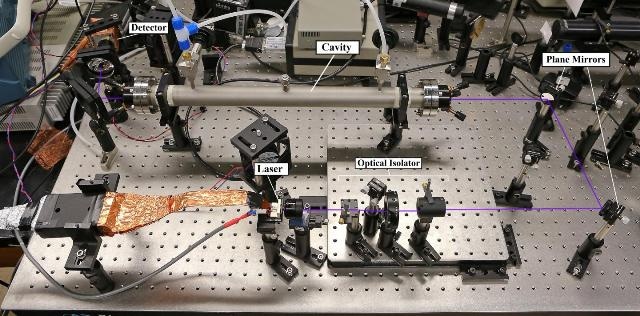Jun 2 2016
A major pollutant emitted by fossil fuel burning power plants and cars, is nitrogen dioxide (NO2). NO2 could cause irritation in the lungs, add to the formation of smog, and result in premature deaths worldwide.
 Experimental setup for ultrasensitive real-time trace gas sensor using a high power multimode diode laser and cavity ringdown spectroscopy. (Credit: Adelphi University, Garden City, NY 11530)
Experimental setup for ultrasensitive real-time trace gas sensor using a high power multimode diode laser and cavity ringdown spectroscopy. (Credit: Adelphi University, Garden City, NY 11530)
In a recent study conducted at Kings College, London, UK, over 5,000 premature deaths in London per year could be due to NO2 pollution. This shows that it is crucial to observe and control pollution gases.
A novel device that can detect very low concentrations of gases including NO2, instantaneously and accurately has been created by a research group from Adelphi University, Garden City, New York, USA. This instrument is unaffected even when there are slight vibrations, making it ideal for use in the field, where it might be shaken by near-by machinery, passing cars, air currents, or thermal changes. The scientists have reported their discovery in The Optical Society’s journal Applied Optics.
Our sensor is much faster and has the potential for much higher sensitivity – if employing better matched optical mirrors – than the previously reported results. It opens the door to interesting, real-time investigation of trace gas concentrations.
Gottipaty Rao, Physicist, Adelphi University
The detector leverages a tried-and-true measurement method, referred to as cavity ring-down spectroscopy (CRDS). Using the CRDS technique, a laser can shoot a light pulse into an accurately aligned cavity produced by mirrors. This light bounces about the cavity and leaks out gradually as soon as the pulse is over. The time taken for the light to escape is known as the ring-down time. The ring-down time would reduce if the cavity contained a little amount of gas that absorbs the laser wavelength, as some amount of light is lost due to absorption. Determining the ring-down time change represents the trace gas concentration.
The laser should be resonant with the cavity for the sensors to work. In other words, the light’s wavelength should match the length of the cavity so that the light bounces about for a long period of time. Given the fact that slight changes in the cavity length could decrease the sensitivity dramatically, standard CRDS sensors are prone to vibration-induced errors. Therefore, in order to use CRDS in the field, specialized vibration-isolation apparatus should be used.
One possible way to resolve the vibration sensitivity would be to move the cavity and the laser alignment so that the laser would be resonant with the cavity in multiple ways. The other resonance serve as back-up when a single resonance is removed by a change in length as a result of vibration. Conversely, this fix decreases the detector’s sensitivity.
Another approach was used by Rao and his team where they utilized a high-power broadband laser that includes broader range of wavelengths when compared to CRDS lasers. Any slight change in the length of cavity due to the vibrations changes the cavity resonance to other wavelengths that were already emitted by the laser.
The scientists analyzed the instrument by determining minute concentrations of NO2.
If the wavelength of the laser is changed, the technique could also readily be applied to monitor other gases such as methane (a powerful greenhouse gas), ammonia (an air pollutant) and sulfur dioxide (a pollutant from fossil fuel burning power plants).
Gottipaty Rao, Physicist, Adelphi University
Rao added that monitoring of atmospheric NO2 is being done by chemiluminenscence, a light generating chemical reaction. However, it cannot measure in real time and needs a detailed calibration procedure to determine the gas’ absolute concentration. CRDS is advantageous over chemiluminenscence and Rao hopes that the new detector would convert it into a more practical device in the field.
Further, the determination of slight concentrations of certain gases in the exhaled breath of a person can be used for diagnosing some diseases or conditions. This instrument may ultimately help doctors in non-invasive breath analysis.
More importantly, our approach may also prove useful in developing a highly sensitive explosive detector — especially applicable to security and air travel — that targets nitro group (NO2) based explosives such as TNT, GN, RDX, HMX, PETN and TATB. Even though the CRDS technique is powerful for trace gas detection, it has found limited use for field based monitoring applications primarily because of its sensitivity to vibrations. We demonstrate a simplified approach that makes the CRDS technique insensitive to vibrations and can be employed for field-based applications by an appropriate choice of a high power multimode laser and the species of interest.
Gottipaty Rao, Physicist, Adelphi University
According to the group, the sensitivity of the device and its response time can be improved further by optimizing the cavity design and using better reflectivity mirrors. “This would open up new possibilities in atmospheric monitoring, chemical reaction studies and explosive detection,” said Rao.